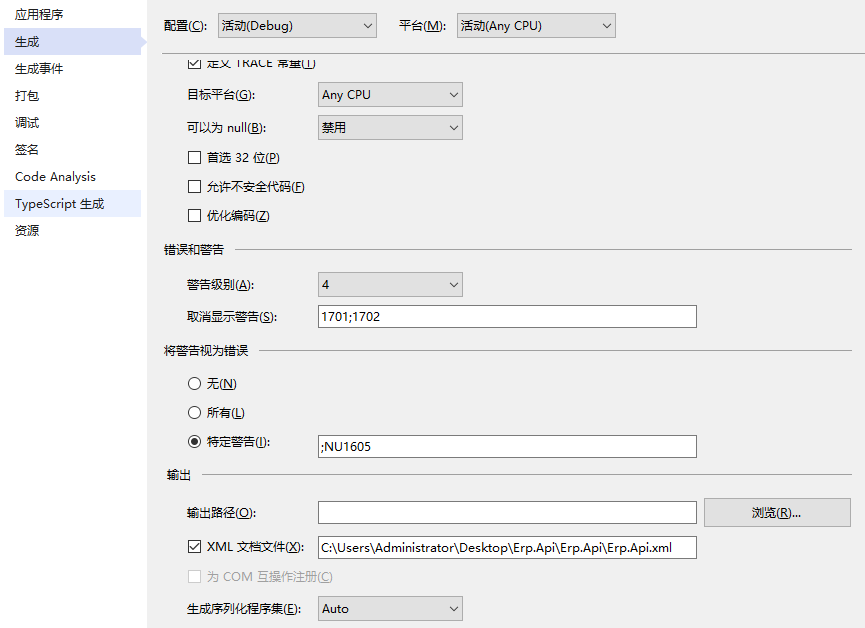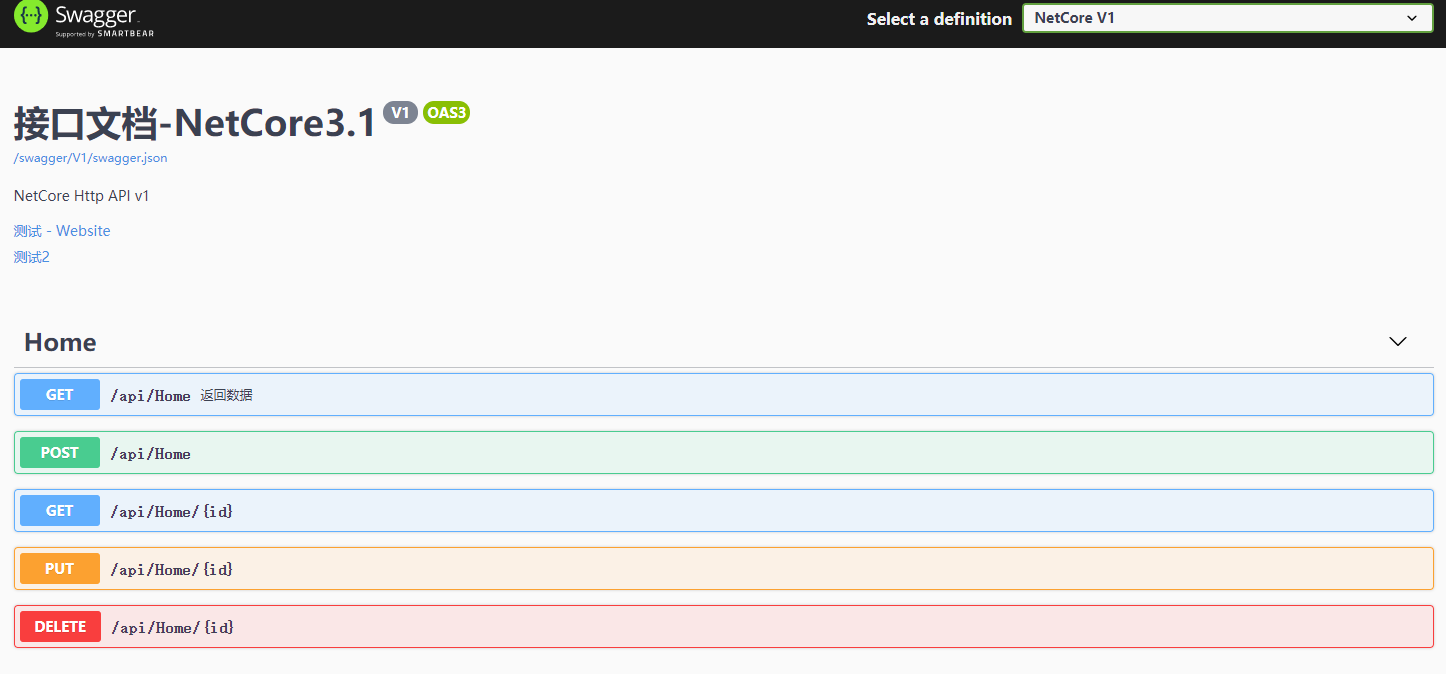.NetCore使用Swagger+API多版本控制
一只奋斗的小小鸟 人气:0本文实例环境及版本.NetCore3.1、Swagger6.1
现在的开发大部分都是前后端分离的模式了,后端提供接口,前端调用接口。后端提供了接口,需要对接口进行测试,之前都是使用浏览器开发者工具,或者写单元测试,再或者直接使用Postman,但是现在这些都已经out了。后端提供了接口,如何跟前端配合说明接口的性质,参数等这也是一个问题。有没有一种工具可以根据后端的接口自动生成接口文档,说明接口的性质,参数等信息,又能提供接口调用等相关功能呢?答案是有的。Swagger 是一个规范和完整的框架,用于生成、描述、调用和可视化 RESTful 风格的 Web 服务。而作为.net core开发,Swashbuckle是swagger应用的首选!
总体目标是使客户端和文件系统作为服务器以同样的速度来更新。文件的方法、参数和模型紧密集成到服务器端的代码,允许 API 来始终保持同步。Swagger 让部署管理和使用功能强大的 API 从未如此简单。
Swashbuckle.AspNetCore源码地址:https://github.com/domaindrivendev/Swashbuckle.AspNetCore
整个swagger页面访问流程如下:
1、浏览器输入swaggerUI页面地址,比如:http://localhost:5000/swagger/index.html,这个地址是可配置的
2、请求被SwaggerUI中间件拦截,然后返回页面,这个页面是嵌入的资源文件,也可以设置成外部自己的页面文件(使用外部静态文件拦截)
3、页面接收到Swagger的Index页面后,会根据SwaggerUI中间件中使用SwaggerEndpoint方法设置的文档列表,加载第一个文档,也就是获取文档架构信息swagger.json
4、浏览器请求的swagger.json被Swagger中间件拦截,然后解析属于请求文档的所有接口,并最终返回一串json格式的数据
5、浏览器根据接收到的swagger,json数据呈现UI界面
一、Swagger基本使用
1、新建NetCore项目,添加相关Controller并添加引用Swashbuckle.AspNetCore.Swagger
2、在Startup中添加配置
在ConfigureServices中注入Swashbuckle服务
services.AddSwaggerGen(c =>
{
c.SwaggerDoc("V1", new OpenApiInfo
{
//版本
Version = "V1",
//标题
Title = $"接口文档-NetCore3.1",
//描述
Description = $"NetCore Http API v1",
//联系方式
Contact = new OpenApiContact { Name = "测试", Email = "", Url = new Uri("https://www.cnblogs.com/mzflog/") },
License = new OpenApiLicense { Name = "测试2", Url = new Uri("https://www.cnblogs.com/mzflog/") }
});
// 加载XML注释
c.IncludeXmlComments(XmlCommentsFilePath);
});
新增XmlCommentsFilePath 属性,此时需要引用Microsoft.Extensions.PlatformAbstractions
/// <summary>
/// 获取当前项目名的XML文件
/// </summary>
static string XmlCommentsFilePath
{
get
{
var basePath = PlatformServices.Default.Application.ApplicationBasePath;
var fileName = typeof(Startup).GetTypeInfo().Assembly.GetName().Name + ".xml";
return Path.Combine(basePath, fileName);
}
}
在Configure中添加Swagger中间件UseSwagger,UseSwaggerUI
UseSwagger:添加Swagger中间件,主要用于拦截swagger.json请求,从而可以获取返回所需的接口架构信息
UseSwaggerUI:添加SwaggerUI中间件,主要用于拦截swagger/index.html页面请求,返回页面给前端
app.UseSwagger();
app.UseSwaggerUI(c =>
{
c.SwaggerEndpoint($"/swagger/V1/swagger.json", $"NetCore V1");
//c.RoutePrefix = string.Empty; //如果是为空 访问路径就为 根域名/index.html,注意localhost:8001/swagger是访问不到的
//路径配置,设置为空,表示直接在根域名(localhost:8001)访问该文件
c.RoutePrefix = "swagger"; // 如果你想换一个路径,直接写名字即可,比如直接写c.RoutePrefix = "swagger"; 则访问路径为 根域名/swagger/index.html
});
右键项目属性在生成中添加XML

此时通过http://localhost:端口号/swagger即可访问

二、Swagger结合版本控制
版本控制的好处:
1、有助于及时推出功能, 而不会破坏现有系统。
2、它还可以帮助为选定的客户提供额外的功能。
1、添加对Microsoft.AspNetCore.Mvc.Versioning和Microsoft.AspNetCore.Mvc.Versioning.ApiExplorer的引用,本文使用版本4.1.0
2、在ConfigureServices中
services.AddApiVersioning(option =>
{
// 可选,为true时API返回支持的版本信息
option.ReportApiVersions = true;
// 请求中未指定版本时默认为1.0
option.DefaultApiVersion = new ApiVersion(1, 0);
//版本号以什么形式,什么字段传递
option.ApiVersionReader = ApiVersionReader.Combine(new HeaderApiVersionReader("api-version"));
// 在不提供版本号时,默认为1.0 如果不添加此配置,不提供版本号时会报错"message": "An API version is required, but was not specified."
//option.AssumeDefaultVersionWhenUnspecified = true;
//默认以当前最高版本进行访问
//option.ApiVersionSelector = new CurrentImplementationApiVersionSelector(option);
}).AddVersionedApiExplorer(opt =>
{
//以通知swagger替换控制器路由中的版本并配置api版本
opt.SubstituteApiVersionInUrl = true;
// 版本名的格式:v+版本号
opt.GroupNameFormat = "'v'VVV";
//是否提供API版本服务
opt.AssumeDefaultVersionWhenUnspecified = true;
});
//方式一 (不建议使用) 此种方式报警告:ASP0000 从应用程序代码调用“BuildServiceProvider”会导致创建单例服务的附加副本。考虑替代方案,例如将依赖注入服务作为“配置”的参数
services.AddSwaggerGen(options =>
{
// 解析IApiVersionDescriptionProvider服务
var provider = services.BuildServiceProvider().GetRequiredService<IApiVersionDescriptionProvider>();
//为每个发现的API版本添加一个swagger文档 可跳过不需要记录的
foreach (var description in provider.ApiVersionDescriptions)
{
options.SwaggerDoc(description.GroupName, CreateInfoForApiVersion(description));
}
//加载XML注释 并启用控制器的注释信息默认为false不启用
options.IncludeXmlComments(XmlCommentsFilePath,true);
});
//方式二 (建议使用)
services.AddSwaggerGen();
//解决上面报ASP0000警告的方案
services.AddOptions<SwaggerGenOptions>()
.Configure<IApiVersionDescriptionProvider>((options, service) =>
{
options.ResolveConflictingActions(apiDescriptions => apiDescriptions.First());
// 添加文档信息
foreach (var item in service.ApiVersionDescriptions)
{
options.SwaggerDoc(item.GroupName, CreateInfoForApiVersion(item));
}
//给swagger添加过滤器
//options.OperationFilter<SwaggerParameterFilter>();
// 加载XML注释
options.IncludeXmlComments(XmlCommentsFilePath, true);
});
添加CreateInfoForApiVersion方法
static OpenApiInfo CreateInfoForApiVersion(ApiVersionDescription description)
{
var info = new OpenApiInfo()
{
//标题
Title = $".NET Core API for 测试项目 {description.ApiVersion}",
//当前版本
Version = description.ApiVersion.ToString(),
//文档说明
Description = "api项目 当前环境-" + EnvironmentName,
//联系方式
Contact = new OpenApiContact() { Name = "标题", Email = "", Url = null },
TermsOfService = new Uri(""),
//许可证
License = new OpenApiLicense() { Name = "文档", Url = new Uri("") }
}; //当有弃用标记时的提示信息
if (description.IsDeprecated)
{
info.Description += " - 此版本已放弃兼容";
}
return info;
}
3、在Configure中添加
IApiVersionDescriptionProvider:用于枚举定义的API版本的API版本描述符提供程序
public void Configure(IApplicationBuilder app, IWebHostEnvironment env, IApiVersionDescriptionProvider provider)
//添加Swagger中间件,主要用于拦截swagger.json请求,从而可以获取返回所需的接口架构信息
app.UseSwagger(opt =>
{
//路由模板,默认值是/swagger/{documentName}/swagger.json,这个属性很重要!而且这个属性中必须包含{documentName}参数。
//opt.RouteTemplate= "/swagger/{documentName}/swagger.json";
// 表示按Swagger2.0格式序列化生成swagger.json,这个不推荐使用,尽可能的使用新版本的就可以了
//opt.SerializeAsV2
});
//添加SwaggerUI中间件,主要用于拦截swagger / index.html页面请求,返回页面给前端
app.UseSwaggerUI(options =>
{
// 为每个版本创建一个JSON
foreach (var description in provider.ApiVersionDescriptions)
{
//这个属性是往SwaggerUI页面head标签中添加我们自己的代码,比如引入一些样式文件,或者执行自己的一些脚本代码
//options.HeadContent += $"<script type='text/javascript'>alert('欢迎来到SwaggerUI页面')</script>";
//展示默认头部显示的下拉版本信息
//options.SwaggerEndpoint($"/swagger/{description.GroupName}/swagger.json", description.GroupName.ToUpperInvariant());
//自由指定头部显示的下拉版本内容
options.SwaggerEndpoint($"/swagger/{description.GroupName}/swagger.json", "coreApi" + description.ApiVersion);
//如果是为空 访问路径就为 根域名/index.html,注意localhost:8001/swagger是访问不到的
//options.RoutePrefix = string.Empty;
// 如果你想换一个路径,直接写名字即可,比如直接写c.RoutePrefix = "swagger"; 则访问路径为 根域名/swagger/index.html
options.RoutePrefix = "swagger";
}
});
4、在api的Controller中添加版本
[ApiVersion("1.0", Deprecated = false)] //Deprecated是否弃用该版本 默认为false不弃用。即使标记了弃用此接口还是会显示,只是做个提示此版本将会被弃用了。
[Route("api/[controller]")]
[ApiController]
//[ApiExplorerSettings(IgnoreApi = true)] 隐藏该接口Controller
public class ValuesController : Controller [Obsolete] //弃用该Action方法 [ApiExplorerSettings(IgnoreApi = true)] //隐藏该Action方法 public IEnumerable<string> Get()
为体验版本控制在新建一个控制器并添加 [ApiVersion("2.0")]
此时访问页面,在右侧的下拉框中可选择不同的版本,会展示不同版本下的控制器。

才疏学浅,相关文档等仅供自我总结,如有相关问题可留言交流谢谢。
原文地址:https://www.cnblogs.com/mzflog/p/14969620.html
世界再大也有尽头!
加载全部内容